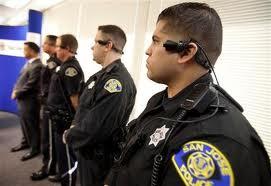Law-enforcement technologyMore police departments make officers wear headcams
The Salt Lake Police Department is following other law enforcement agencies by having officers wear headgear with cameras attached; a police chief in Salt Lake is taking it one step further by announcing his intention to make the cameras mandatory at his department; this would allow police officers in Salt Lake to record any crime or interaction with the public

These San Jose officers are testing headcams // Source: sz6gou.com
The Salt Lake Police Department is following other law enforcement agencies by having officers wear headgear with cameras attached. A police chief in Salt Lake is taking it one step further by announcing his intention to make the cameras mandatory at his department.
This would allow police officers in Salt Lake to record any crime or interaction with the public. Supporters of this technology say the equipment is made in a way that makes it impossible for police to edit the information, but some are concerned about privacy issues associated with the technology.
The BBC reports that currently, 274 agencies around the United States use some sort of camera on the headgear of officers in their departments, and others are testing various units.
Taser, a U.S. firm, has created the design called Axon Flex, which is an upgrade of its Axon Pro video system. The main difference between the two versions is that the Axon Pro can be attached to spectacles.
“All of our motor officers are using the most current camera on a daily basis,” Commander Scott Schubert from Pittsburgh Police Department told BBC News.
“Unlike an in-car video that stays positioned in front of the car, the helmet or glasses-mounted cameras go wherever the officer goes and records what the officer observes. I think it’s a great resource because it provides transparency and helps to ensure accountability, by the officers and the public, during police interaction.
“It also provides valuable information that can assist with the successful prosecution of crimes, protect officers from false complaints, and assist with addressing valid complaints involving police conduct.”
Erick Gieseke, a captain in the Burnsville, New Mexico Police Department, says the upgraded version provide a level of comfort to the equation.
“We are using both versions, started using them in 2010, and officers can wear the first ones as a headband or clip to their hats using a magnetic piece - but the latest version can be clipped onto their eyeglasses,” Gieseke told the BBC.
“The cameras allow the officers to record the incidents they were involved with to essentially preserve the truth, and they give them a tool to support their actions, to demonstrate the many difficulties and challenges they encounter.
“It’s also been a great tool documenting evidence on crime scenes, exactly as it is when we get there.”
Gieseke also added that like most information gathered by police, the public can access that the footage.
In the United Kingdom, Grampian Police officers in Aberdeen have been using “body cameras” since 2010.
Nick Pickles, the director of the Big Brother Watch campaign group is concerned about the cameras being used to catch things that police are not investigating.
“We’re already seeing traffic wardens, bailiffs and council officials using them in Britain and it’s a sad indictment of authorities who see every member of the public as a suspect,” Pickles said.
“What is the problem they are trying to solve? Are lots of police officers being assaulted and people getting off because there’s no CCTV? Of course not,” Pickles said.“This is a one-sided tool. How would police officers react if members of the public routinely filmed them?”
